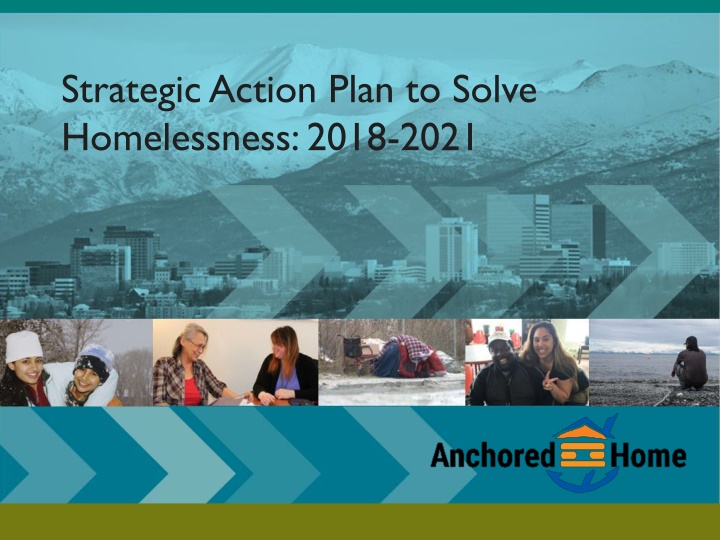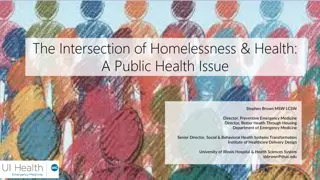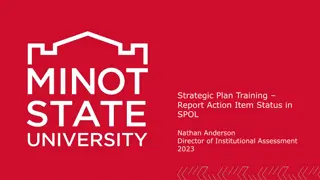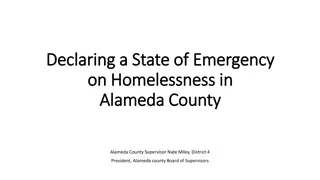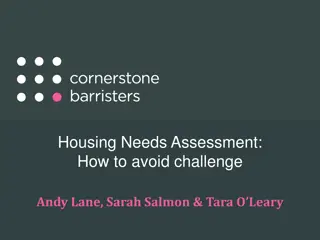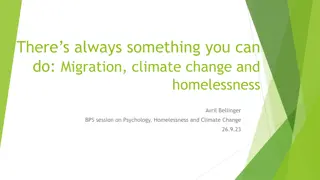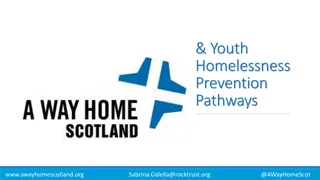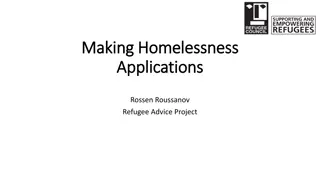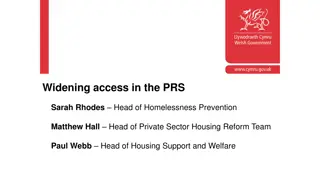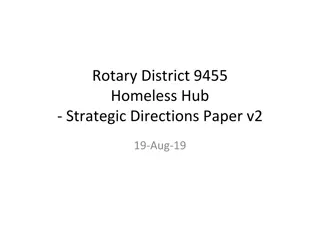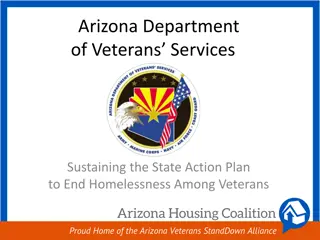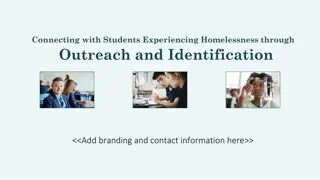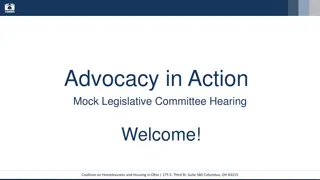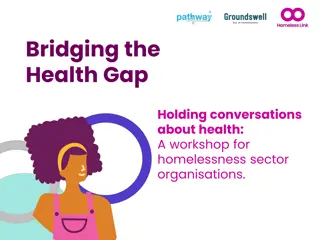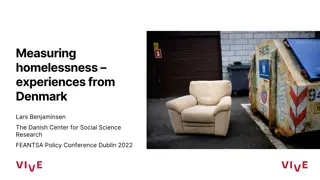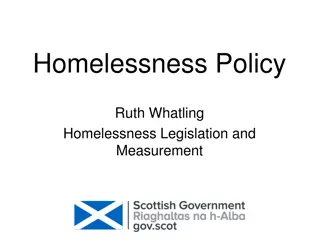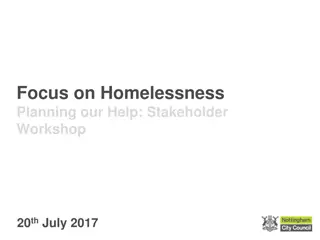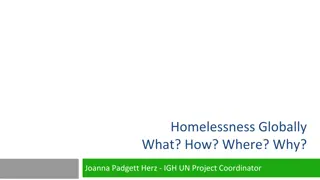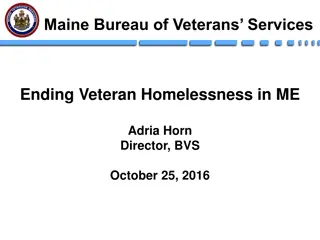Strategic Action Plan to Solve Homelessness 2018-2021
Anchored Home is a roadmap to make homelessness a rare, brief, and one-time event. Key success elements include a unified, coordinated system, crisis response connectivity, data-driven prioritization, Housing First philosophy, and collaborative resource alignment across sectors. The goal is to create a unified Anchorage system with access to housing and services, implementing a community-wide approach through Coordinated Entry and the Homeless Management Information System. Community outreach efforts engage various stakeholders to address homelessness comprehensively.
Download Presentation

Please find below an Image/Link to download the presentation.
The content on the website is provided AS IS for your information and personal use only. It may not be sold, licensed, or shared on other websites without obtaining consent from the author.If you encounter any issues during the download, it is possible that the publisher has removed the file from their server.
You are allowed to download the files provided on this website for personal or commercial use, subject to the condition that they are used lawfully. All files are the property of their respective owners.
The content on the website is provided AS IS for your information and personal use only. It may not be sold, licensed, or shared on other websites without obtaining consent from the author.
E N D
Presentation Transcript
Strategic Action Plan to Solve Homelessness: 2018-2021
Anchored Home is a roadmap to make homelessness a rare, brief and one-time event 2
Key Success Elements Needed Unified, coordinated system (known as Coordinated Entry) that quickly assesses and matches people to the most appropriate housing and services, including rapid rehousing, supportive housing, and/or other housing interventions. Crisis response system connected: (emergency shelter, street outreach, police, and community patrol, etc.) quickly connects to services and Coordinated Entry. Data-driven approach to prioritizing housing assistance. Housing First philosophy. Housing availability known: providers and owners accept referrals directly from the Coordinated Entry process and work to house people as quickly as possible, using standardized application and screening processes. Collaboration across sectors: Policymakers, funders, and providers (including social, health, and behavioral health services, benefit and entitlement programs, and other essential services) collaboratively develop and align resources. Source: US Interagency Council on Homelessness, Sept 2016 3
Goal: Create a Unified Anchorage System Access to Housing and Services Data Housing Services Outcomes Random, 1st come, 1st serve Former approach fragmented, siloes, and disconnected Ad hoc, minimal, siloed Temporary, congregate, transitional under housing ready Tied to temporary residence programs Expressed in units of service or clients served Anchored Home system unified community system Coordinated Entry outreach and prioritization Unified through the Homeless Management Information System Housing first approach Units secured Services coordinated over time Housing stability 4
Community Outreach Engaged over 2000 community members, businesses and agency representatives by 2020: Community gatherings 2018 and 2019 Anchorage Assembly Homelessness Committee and individual Assembly members Housing, Homeless and Neighborhood Development (HHAND) Commission Anchorage Coalition to End Homelessness (ACEH) member meetings Outreach to Federation of Community Councils and 30 plus Community Councils meetings to date On-going discussions with people with lived experience of homelessness Consultation with housing and social service agencies across Alaska and the US One-on-one meetings and group discussions with stakeholders, including the many individuals and organizations recognized in the Anchored Home Plan 5
Pillar 1: Prevention and Diversion Strengthen Anchorage s community-based services to better identify and support individuals and families who are at immediate or probable risk of experiencing homelessness. Better coordinate resources to reduce returns to homelessness. 7
Pillar 2: Housing and Support System Build and maintain a robust and coordinated system of housing, case management and other supports adequate to house the people who need it, with connections to meaningful work and community. Collect, analyze and share data to set targets, monitor results, and report back. 8
Pillar 3: Public Health and Safety Resolve public health and safety issues related to homelessness through resource allocation and policy improvements. Balance safety net and social service resources across the community to adequately address unsheltered homeless persons. Revitalize Anchorage s downtown and community neighborhoods with a mix of housing and commerce. 9
Pillar 4: Advocacy and Funding Build public will to achieve functional zero. Secure necessary resources to achieve the vision. 10
What Happens in 2021? Anchored Home migrates fully into ACEH ACEH s new governance structure seeks continued enhancement of the collective action model: those with lived experience, providers, government/private and philanthropic partners working together to solve homelessness Anchored Home pillars will be blended into ACEH s work as core foundational members transition out of the work in 2021 Continued engagement of the city for Public Health and Safety with a potential focus on the Anchorage Health Department ACEH Advisory Council s Annual Gap Analysis and Community Priorities will target yearly priorities and goals each spring (evaluating supply, demand, gaps and priorities) Continuous Quality Improvement Build on successes (Gap Analysis, new programming, data centered focus, advocacy, community engagement etc.) Incorporate lessons learned (outreach pilot, communication strategy with the public) Continued evaluation of COVID-19 impacts and resulting systemic changes (Mass shelters and rapid housing, prevention and diversion focus) 11
Building a Continuum ACEH s goal is to connect a full continuum of evidence-based, cost- effective interventions to make homelessness rare, brief and one time. We call this the Homeless Prevention and Response System. Higher need/intensity Lower acuity/intensity Provide dynamic leadership to unite Anchorage in making homelessness rare, brief and one-time. 12
Partner and Member Voices Houseless Resource Advisory Council (HRAC) Homelessness Leadership Council (HLC) Provider Voices 13
